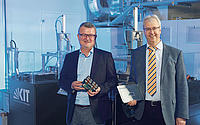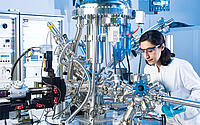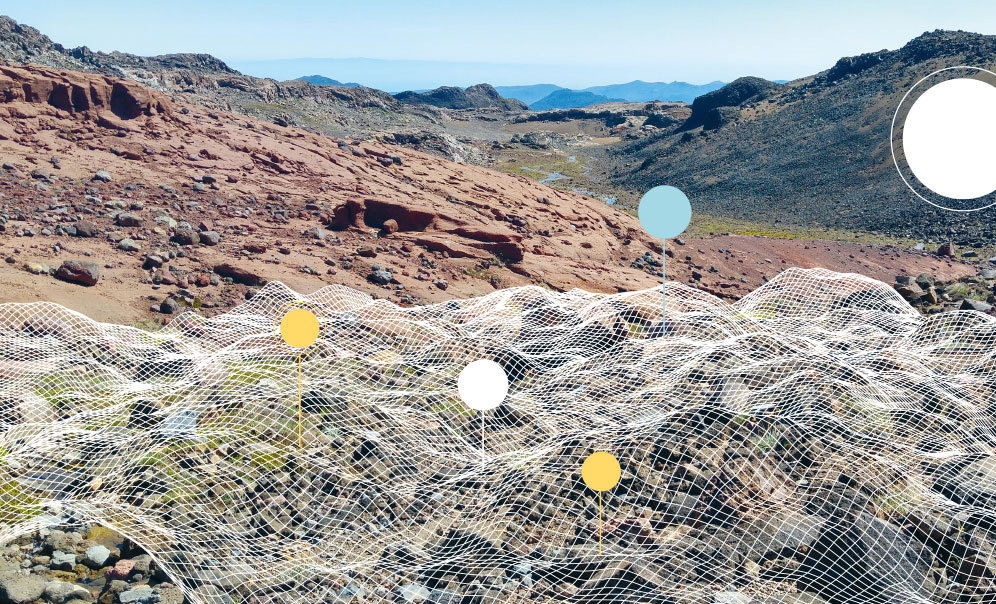- Energy
- Climate, Environment & Health
- Materials
- Production
STORAGE IN SUSTAINABLE HANDS

Lithium and cobalt are precious raw materials. They form the basis of lithium-ion batteries, which not only supply cell phones and laptops with power, but also feed more and more electric vehicles with energy. However, while demand for high-performance energy storage devices is rising, raw material deposits are steadily dwindling. Added to this are geopolitical uncertainties: For example, by far the largest deposits of cobalt are found in the Congo – a country marked by civil wars, where the raw material is still being mined in part under inhumane conditions.
"It is up to us researchers to develop solutions today for the challenges of the future," says Prof. Maximilian Fichtner, director of CELEST and deputy director of the Helmholtz Institute in Ulm (HIU), which was initiated at the Karlsruhe Institute of Technology (KIT).
In order to strengthen cooperation and consolidate joint research activities, the University of Ulm and the Center for Solar Energy and Hydrogen Research Baden-Wuerttemberg (ZSW), together with KIT, founded CELEST in January 2018, the largest German research and development platform for energy storage systems. The acronym stands for Center for Electrochemical Energy Storage Ulm & Karlsruhe.
The focus of CELEST is on three topics: Lithium-ion technology, energy storage beyond lithium and alternative technologies for electrochemical energy storage, such as fuel cells or redox flow batteries. "It was important to us to bundle specific competencies without being too thematically restricted. This allows us to further develop existing technologies such as the lithium-ion battery, but at the same time to think outside the box and conduct research with alternative raw materials," explains Prof. Helmut Ehrenberg. He leads the Institute for Applied Materials – Energy Storage Systems (IAM-ESS) at KIT and serves as deputy director of CELEST.
Ehrenberg also emphasizes: "With CELEST, we are finally giving battery research the attention that is demanded by society. Here, technologies can be tested in an overall context instead of only looking at individual components and processes."
Currently, CELEST members are researching magnesium and sodium-ion batteries, among other things. These raw materials are available in Europe in larger quantities, are non-toxic and easy to recycle. Compared with lithium-ion batteries, however, they have a lower energy density and are thus much heavier for the same power output. "When it comes to stationary applications, however, low mass is not absolutely necessary. It rather counts that the storage medium is durable and cost-effective and that you leave a footprint that is less harmful to the environment. My vision is sustainable energy technology," says Ehrenberg.
The company also wants to set the course for the future in the area of education and training. Plans are currently focusing on a joint graduate school. Fichtner explains: "We want to provide society not only with technical innovations, but also with well-trained personnel. Training plays a central role at CELEST; after all, qualified young scientists form the basis for the success of our research."
"However, we are only really successful when our research results also meet the induytry’s interest" Fichtner emphasizes. One year after the launch of CELEST, the combined research expertise is already bearing fruit. A wide variety of cooperation partners are in contact with the researchers, such as material manufacturers and mobility service providers. The Battery Technology Center at KIT's North Campus also plays an important role – a research factory where projects with high market proximity are implemented. From the development of new materials and cells to their integration into the overall system, holistic approaches are pursued here in cooperation with industry. Ehrenberg and Fichtner are optimistic about the future: "Good foundations have been laid. Now it's up to us to make something out of it."
"Despite the physical distance, it's a huge advantage to have partners with whom you can exchange ideas. From basic research to application, we can benefit from the accumulated expertise of all CELEST members."
Pictures f.u.t.d.: Stocksnapper / Shutterstock, edited by DER PUNKT | Andreas Drollinger / KIT




